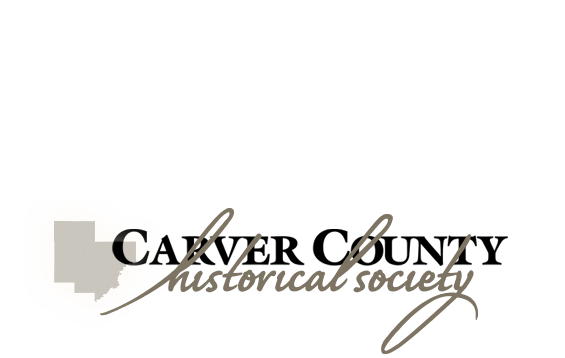Ghost Towns
When was the last time someone suggested heading over to Oberle's Corners for a bite to eat? Oberle's Corners is one of the county's numerous ghost towns. Ghost towns bring to mind images of long deserted buildings with boarded up windows, but that's not what most ghost towns look like. Ghost towns are simply former towns; places settled and then abandoned. There are many reasons why a town might not survive: being circumvented by the railroad, poor location, or being enveloped by a neighboring town. For whatever reason, the community did not become, or could not remain, a town with a governing body. Some of these cities disappeared quickly, others were swallowed up by larger, faster growing cities. But even if they cannot be called towns, some are still used as reference points in the county.
Every state in the United States has ghost towns, and they are part of the history of a region. In Carver County, there are around twenty-one ghost towns. Their names are Swede Lake, Hazelton, Helvetia, Hollywood, Mound St. Clair, Purity, Camden, Hyde’s Lake, Schnapesburg, Assumption, Benton, Dahlgren, West Union, San Francisco, Yorkville, Oberles Corners, Augusta, Bongards, Gotha, and Scandia. Here's a map to help you orient yourself as you wander through our county's past.

These towns were religious communities, immigrant communities, farming towns, river towns, or railroad towns. Sometimes towns only existed on paper, not in reality. A speculator or developer would buy land from the government very cheaply, divide it up into plots on a map, and try to sell the plots to build a town. Many times they failed to sell, and the “paper town” only existed as a name on a map.
A town needs many things for success, but they all fall into five main categories. First is access to enough natural resources, such as water, good soil, hunting grounds, and trees. Second, access to transportation such as ferries, steamboats, trains, cars, wagons, or buses can help a town thrive or fail. Strong organization makes a town more likely to thrive. Another key factor is citizens invested in the town, with a variety of roles to play. Finally, luck plays a pivotal role. Towns faced with disease or natural disasters often have a hard time recovering and rebuilding.
Other factors besides bad luck can contribute to the failure of a town. Fear of the unknown, like an unfamiliar land or unknown people, or fear of the Native Americans whose land they were taking, could make residents reluctant to stay. Even when immigrants settled in communities with others from the same country, sharing a culture and way of life, that very lack of diversity sometimes proved problematic in the town’s eventual success.
San Francisco, named for the California city, was an early Carver County town that ultimately failed. It was founded by William Foster in 1854. He purchased land along the Minnesota River, divided it into lots, built the first store and a warehouse, and tried to sell other plots. San Francisco was named the first county seat soon after. The first school opened 1857-1858 with teacher Levi Williams and 1859 saw the start of a ferry operation across the river. On May 11, 1858, a meeting held in William Foster’s warehouse declared San Francisco an official town. Those attending elected officials like a Mayor and Justice of the Peace.
San Francisco faced problems though, which led to its eventual abandonment. One of the first, and most important, was the county seat being moved to Chaska in 1856, eliminating one of the key reasons people visited the town. Second, the town site was located below a series of rapids on the river, which led to poor river travel and frequent flooding. In 1863, flooding washed away the warehouse and several other buildings. Many were not rebuilt as flooding was a consistent problem. Eventually, San Francisco’s population dwindled, and the town site became private farmland. In the end, San Francisco lasted for about ten years.
The Justus family (also spelled Iustus) from Sweden founded the town of Swede Lake, or Gotaholm, in 1856 along the banks of Swede Lake, near Watertown. Settlers founded nearby Watertown the same year. The two towns were unaware of each other, despite being only about two to three miles apart, until Swede Lake resident Abraham Hokinson got lost one night. He wandered until he found shelter in Watertown and told his community about the nearby town when he found his way home. As time went on, Watertown became the more successful community and Swede Lake residents moved to the neighboring town, merging the two.
The Town of Helvetia, built between Hollywood and Watertown townships, was named by residents after their homeland. Helvetia is the ancient name of Switzerland, chosen by the Swiss immigrants who settled the town. John Buhler founded Helvetia in 1856; he also built the first store. Resident Jacob Lahr opened a sawmill and built a bridge over the Crow River for easier travel in 1869. A post office was opened in 1875 and Lahr became the first postmaster. He was succeeded by a Mrs. Zahler and August Ninnemann, under whom the office moved to nearby Mayer in 1889.
With the good came the bad for Helvetia. Roadways did not develop beyond trails through the brush. Families had few resources and struggled to make it. To make things more complicated, the main transportation into town was steamboat. Steamboats were replaced as primary means of transport when trains came to the county in 1871. When the railroad came by Helvetia, it ran a mile south of the townsite and many businesses moved to the new train station. Finally, an outbreak of diphtheria occurred in 1884, killing much of the town’s population. Helvetia’s remaining residents persisted for several more years before the it merged with the community growing around the train station. Together they became the Village of Mayer on June 28, 1900.
Two other communities, those of St. Clair and St. Lawrence (partially in Scott County, partially in Carver County), were “paper towns”. St. Lawrence was laid out by William H. Stodder and Charles L. Pierson in November 1856. Like many towns of the time, it failed. Though the land was divided into plots for sale and development, no structures were ever built. St. Clair was platted on the south fork of the Crow River, in Camden Township, in January 1857. Speculators sold lots to people in the eastern United States, but none ever settled or erected structures in the town.
Some ghost towns still have residents or buildings. For example, Bongards is still home to Bongards Creameries, and Hollywood Township to the Hollywood Sports Complex. Other towns, like logging community West Union, have a church and homes. However, these ghost towns are not incorporated and have no civic institutions such as town officials or a post office. They exist mainly in history books and memories.
The photographs that follow are most of what the museum has for pictures of these lost cities.
Turning Point: In 1900, the town of Helvetia was officially merged with neighboring Mayer, ending independent existence of one of Carver County’s last failed or “ghost” towns.
Chronology:
- 1851: Signing of treaties at Traverse de Sioux and Mendota in July and August legally opens up the land in what becomes Carver County to white settlement.
- 1854: William Foster founds the town of San Francisco, named for the city in California, where he had lived a short time.
- February 20th, 1855: An act of territorial legislature forms Carver County.
- March 3rd, 1855: Carver County is officially declared a county.
- 1856: The county seat is moved from San Francisco to Chaska.
- 1856: The town of Swede Lake is founded in Carver County.
- November 1856: The Town of St. Lawrence is laid out but is never built.
- 1856: The town of Helvetia is founded.
- 1857: The town of St. Clair is platted but is never settled.
- May 11, 1858: San Francisco is officially declared a town, despite no longer being the county seat.
- 1863: Massive flooding occurs in San Francisco when the Minnesota River rises.
- 1884: A diphtheria epidemic breaks out in town of Helvetia.
- 1886: The railroad bypasses Helvetia and creates a new community by its train station.
- June 28, 1900: The communities of Helvetia and Mayer officially merge and become Village of Mayer.
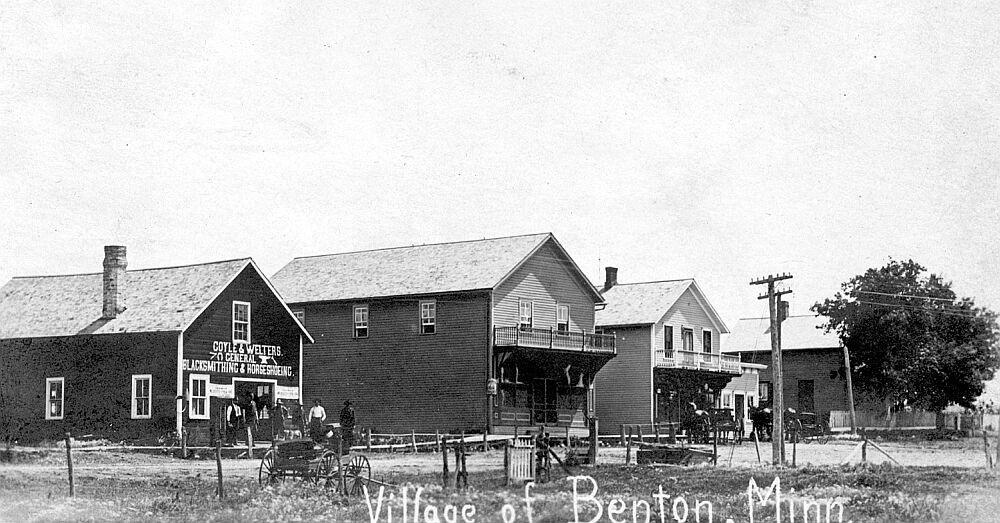
[Av10527]

A group of West Union picnickers clowning around for the Camera. From left to right: (standing) Elin Johnson Nord, Ruth Alexander, Esther Remling. (Sitting) Geo. Alexander, Hilding Anderson, Levi Nelson, Frank Nord, Nonard Anderson, E. Sandquist. [Av6457]

This is a photo of a neighborhood gathering at the Aug. Tengblad home in West Union. It was taken sometime around 1908. [Av1140]
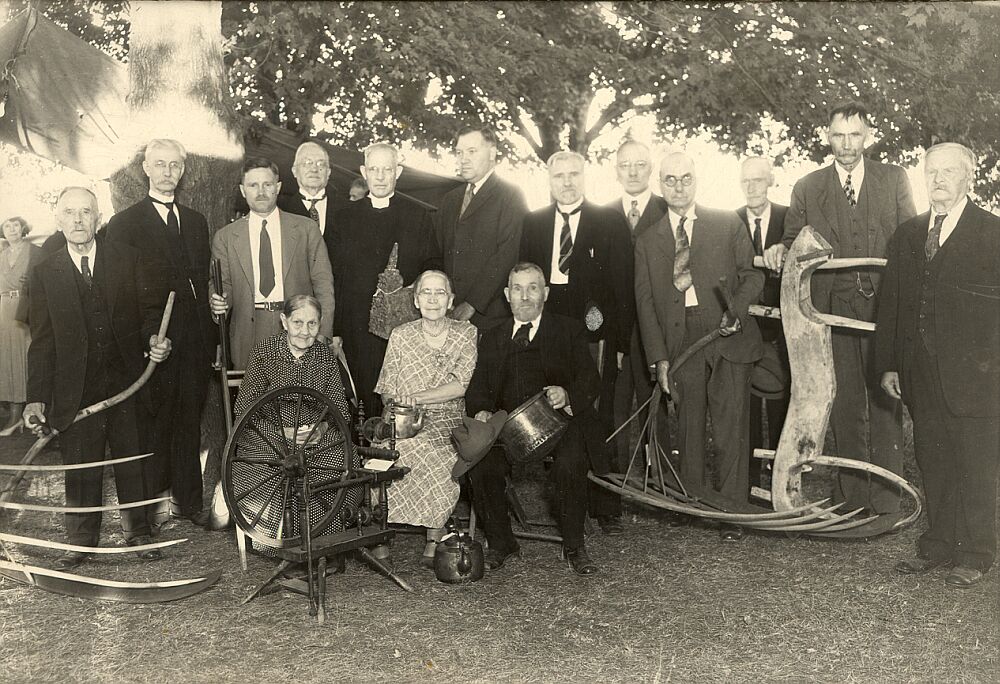
Another photo of a West Union gathering. This photo was taken about 20 years later in 1928 and is a Pioneer Reunion. [Av1159]
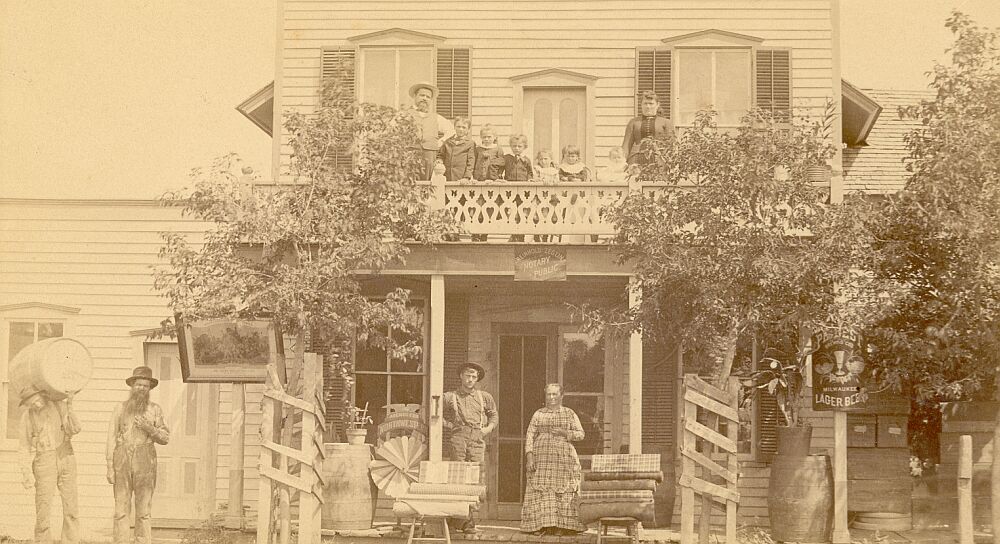
Helvetia was an ancient name for Switzerland. Reinhold Zeglin and his General store served the people of Helvetia. This photo shows the Zeglin family and various community members, and was taken about 1878. [Av5388]
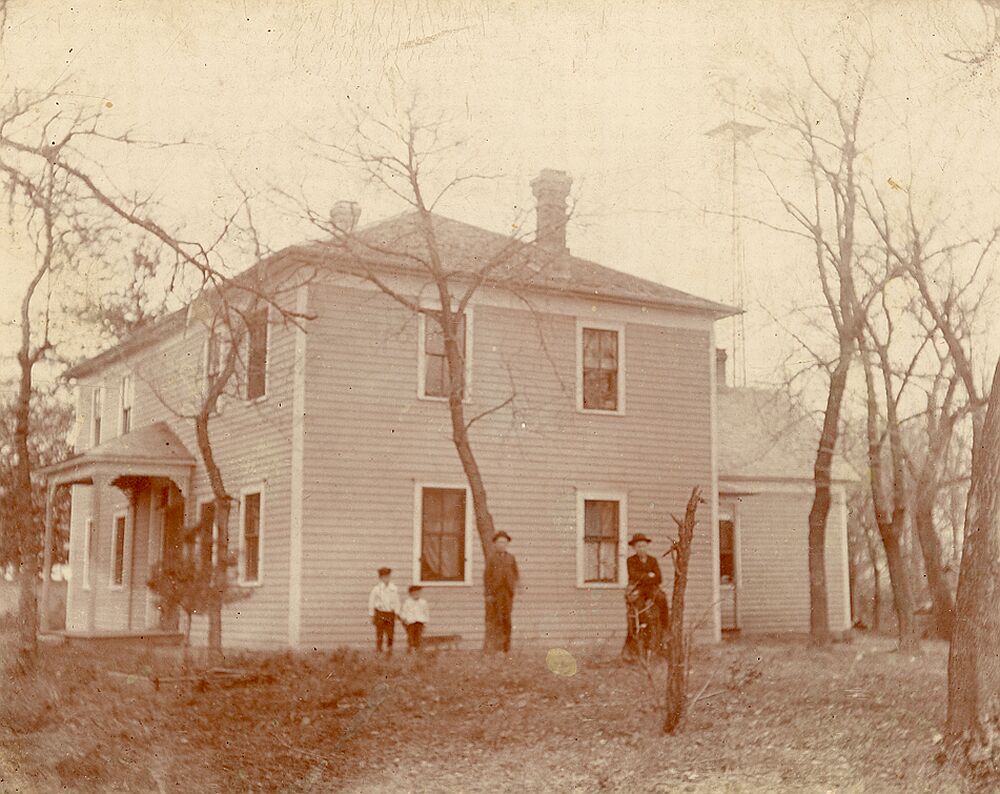
C.W. Hillstrom farm home in San Francisco Township. [Av1836]

Here's another photo from West Union. This one was taken on April 11th, 1887. It's A.B. Johnson's logging crew. [Av6442]
BIBLIOGRAPHY
Primary:
“Ghost Towns" Educational program. Carver County Historical Society.
Holcombe, Maj. R.I., editor. Compendium of History and Biography of Carver and Hennepin Counties, Minnesota. Chicago: Henry Taylor and Company, 1915.
Maravelas, Paul Scheftel. “The Gehl Farm in San Francisco Township, Carver County, with some notes on
the village of San Francisco, the Little Rapids, and the Wahpeton Village at that place”. Site
study. Compiled by the Carver County Historical Society for the U.S. Fish and Wildlife Service,
March 15, 1997.
Mayer Booster Club. History of Helvetia-Mayer and Community. Lester Prairie, MN: Lester Prairie News, 1936.
Thilquist, Susan . “In the Tracks of the Swedish Settlers in Carver County”. Driving tour pamphlet.
Waconia, MN: Carver County Historical Society, 1988.
Warner, George E. and Charles M. Foote. History of the Minnesota Valley: Carver County. Minneapolis: North Star Publishing Company, 1882. Republished 1986.
Watertown Centennial: 1856...1956. Watertown, MN: Watertown Activities, Inc., 1956.
Carver County Historical Society website. Ghost Towns. Accessed December 13, 2012. https://carvercountyhistoricalsociety.org/150th/150th_scrapbook_ghost_towns.html
RELATED RESOURCES
Secondary:
Carter, William. Ghost Towns of the West. Menlo Park, California: Lane Magazine & Book Co., 1971.
Carver County: Today and Yesterday. Compiled by the Carver County Statehood Centennial Committee, 1958.
Egerstrom, Lee, Minnesota 2020. “Minnesota ghost towns haunt 500 endangered small cities”. Daily
Planet, September 26, 2007. http://www.tcdailyplanet.net/article/2007/09/24/minnesota-ghost-towns-haunt-500-endangered-small-cities.html
Kimball, Willis M. “Minnesota’s Ghost Towns”. Minneapolis Journal, May 29, 1932.
Lofstrom, Ted and Lynne VanBrocklin Spaeth. Carver County: A Guide to Its Historic and Prehistoric Places. St. Paul: Minnesota Historical Society Press, 1978.
“Reviews and Notes: Local History Items”. Minnesota History, 13 Issue 3 (September 1932): 295-346. http://collections.mnhs.org/MNHistoryMagazine/articles/13/v13i03p295-346.pdf
Serres, Chris, et. al. “Part 1: Minnesota’s New Ghost Towns”. Star Tribune, April 21, 2008. http://www.startribune.com/local/west/17932454.html
Tremblay, Ruth and Lois Schulstad. Images of America: Carver County. Charleston, South Carolina: Arcadia Publishing, 2011.
Urbanski, Lawrence Eugene. “A study of the disappearance of town settlements in the twenty-eight southern counties of the state of Minnesota”. Thesis paper, Saint Mary’s College, 1950.
Web:
Ghost Towns website. Ghost Towns of Minnesota. Accessed Decmber 13, 2012. http://www.ghosttowns.com/states/mn/mn.html
This article used with the permission of MNopedia, operated by the Minnesota Historical Society, under a Creative Commons License. No changes have been made to the article’s content.
